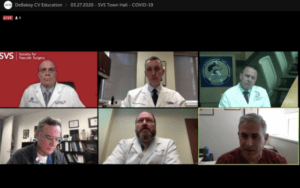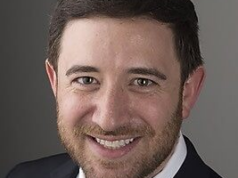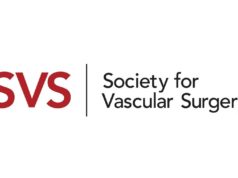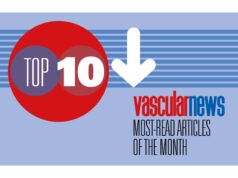
The imperatives of preserving personal protective equipment (PPE) in the throes of the COVID-19 pandemic were discussed in depth during a Society for Vascular Surgery (SVS) Town Hall on the speciality’s early experiences with the coronavirus strain.
Some of the arguments were delivered by Benjamin W Starnes, professor and chief in the division of vascular surgery at the University of Washington in Seattle, USA, who drew on a recent surgical example to highlight why.
His colleague, professor and associate chief Niten Singh received a patient with a ruptured aneurysm who required open repair, Starnes explained. Afterwards, the patient’s left colon died following which further procedures were required, culminating in a myocardial infarction and the placement of a coronary stent—and now palliative care. Multiple providers were in contact with the patient throughout the hospital, Starnes said.
“We cannot do these types of operations,” he continued. “We are doing the emergencies the best we can. But we have got to get the picture here, and that is conserve PPE. Our role is to grow hospital capacity. By growing hospital capacity, I mean not operating. Don not do any elective cases. Nothing. Only emergencies.”
The Town Hall panel, convened on Friday 27 March, consisted of an experienced group of vascular surgery leaders, and was co-moderated by SVS president Kim Hodgson, chair of the division of vascular surgery at Southern Illinois University School of Medicine in Springfield, USA, and Alan Lumsden, the medical director of Houston Methodist DeBakey Heart & Vascular Center in Houston, USA. Starnes has been at the vanguard of the vascular response to COVID-19, operating in, as Hodgson described Washington state, North America’s “ground zero” for the virus.
“We all have this sense of denial,” said Lumsden, responding to the picture painted by Starnes. “Once you are in the middle of it, you get it. But trying to communicate what you’re communicating right now to people who are on that early phase of the curve— we all hope we’re not going to get where you are—but the reality is you’re right; we need to start conserving this now.”
In practice
Starnes elaborated on his team’s current practice as part of an answer to a question from Lumsden on what is done when confronted with a case of deep vein thrombosis (DVT), whose incidence, the DeBakey chief noted, appears to have increased.
“In terms of our hybrid operating room, we are trying to reserve it unless it is absolutely needed,” he said. “We will try to use other operating rooms for any of these procedures. Last week, we had an open repair of a ruptured AAA and a gunshot wound to a carotid. Those were easy to do in a different operating room and reserve in the hybrid operating room.”
Lumsden then asked whether Starnes had been using a portable C-arm in such non-hybrid settings.
“We have not been operating,” Starnes said. “We have cancelled probably two dozen complex aortic cases in the last month. We are following those cases, by the way—not only the aneurysm cases but the critical limb-threatening ischaemia patients. We are going to find out who loses a life and who loses a leg. These are desperate times, and desperate times call for desperate measures.”
Earlier, the panel had been posed the question of what vascular-specific complications surgeons were seeing in light of COVID-19. Starnes had highlighted DVT: “Some of these patients are hypercoagulable and they are developing DVTs—and they need to be treated with anticoagulation. But that causes an issue with all of the ultrasound techs in your lab who are going to be doing these DVT studies. That is the only vascular complication of COVID infection that I am aware of.”
New York
New York is being referred to as the new epicentre of COVID-19 in the USA. Darren B Schneider, chief of vascular and endovascular surgery at Weill Cornell Medical College and director of the Center for Vascular and Endovascular Surgery at New York Presbyterian Hospital in New York, USA, joined the Town Hall panel to provide a snapshot of the frontlines. He said his team had implemented much the same protocol as Starnes described in Seattle.
“For more than a week we have not done any elective cases, not even so-called urgent elective, and it is only true emergencies that are life or limb threatening that we are doing,” Schneider explained. “We have completely closed our vascular lab—no inpatient or outpatient vascular lab studies.”
The role of vascular surgeons in his hospital are shifting, Schneider continued. “Because we have to preserve PPE, facilitate physical and social distancing in order to try to the blunt the epidemic, which is out of control in New York.
“Our role is only to provide essential vascular services and now we are being tapped for other roles. At one of our peripheral hospitals, one of the faculty members is now working in the ICU [intensive care unit] as an intensivist because they have a shortage and all their ICUs are full.”
SVS president Hodgson, meanwhile, highlighted a suggestion from China to limit vascular labs to one room when they can’t be carried out bedside, saying: “What are you doing to clean that room after each case?”
To which Lumsden responded by raising the point of the environmental services responsible for cleaning imaging, hybrid and operating rooms. “They are really put out to task at the moment—that is one of the reasons we are going to try to avoid using our hybrid room if at all possible and switch over to a regular room,” he said.
The panel also included SVS president-elect Ronald L Dalman, professor and chairman of vascular surgery at Stanford University School of Medicine in Stanford, USA, who addressed the re-usability of N95 masks. “There is a couple of different proposals [here],” he said. “There is a heat-based proposal and the other is more of a disinfectant … we are doing some work right now to see if we can validate some of those recommendations. I think the one that is thought to be most effective right now is heat-based. I am not recommending anybody do this but there is a potential for exposing it to heat or steam or some other form of heating that may allow for re-utilization of N95 masks.”
The other panel members were Thomas Forbes, chairman and professor of vascular surgery at the University of Toronto, Canada, and Daniel McDevitt, president and CEO of Peachtree Vascular Specialists in Atlanta, USA.
Contracting COVID-19
There was one other dimension to the Town Hall. The panellists heard from Ali Irshad, a vascular and endovascular surgeon at Hartford HealthCare in Hartford, USA, who was understood to be the first known SVS member to have contracted the virus. Hodgson pointed to the suspected circumstances surrounding Irshad’s infection as representing “a cautionary tale.”
“I had been at a training session for a medical device,” Irshad explained. “One of the reps apparently had symptoms at the time and later tested positive. Twenty-four out of 25 who were part of his group also had symptoms—and also went home. The three of us, the three surgeons, who tested positive were at these training sessions and/or the dinner.” And the trio had not been in particularly close proximity to the individual in question, Irshad added: “The virulence of this was remarkable.”













